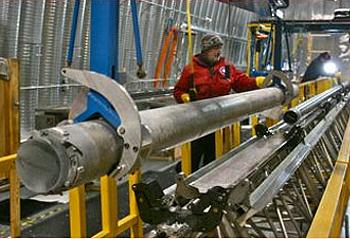
CORVALLIS, Oregon, March 8, 2013 (ENS) – The planet today is warmer than it has been during 70 to 80 percent of the last 11,300 years, finds a new study of ice and sediment cores from sites around the world.
Results of the study, by researchers at Oregon State University and Harvard University, are published this week in the journal “Science.”
With data from 73 ice and sediment core monitoring sites, the scientists have reconstructed Earth’s temperature history back to the end of the last Ice Age. Cores show past air temperatures as well as past sea surface temperatures.

Lead author Shaun Marcott of OSU says that previous research on past global temperature change has focused on the last 2,000 years.
“We already knew that on a global scale, Earth is warmer today than it was over much of the past 2,000 years,” Marcott says. “Now we know that it is warmer than most of the past 11,300 years.”
Analyses of data from the 73 sites allow a global picture of the Earth’s history and provide a new context for climate change analysis.
“The Earth’s climate is complex and responds to multiple forcings, including carbon dioxide and solar insolation,” Marcott says.
“Both changed very slowly over the past 11,000 years,” he said. “But in the last 100 years, the increase in carbon dioxide through increased emissions from human activities has been significant. It’s the only variable that can best explain the rapid increase in global temperatures.”
The research was funded by the Paleoclimate Program in the National Science Foundation’s Division of Atmospheric and Geospace Sciences.
“This research shows that we’ve experienced almost the same range of temperature change since the beginning of the industrial revolution as over the previous 11,000 years of Earth history, but this change happened a lot more quickly,” says Candace Major, program director in the National Science Foundation’s Division of Ocean Sciences.
“The last century stands out as the anomaly in this record of global temperature since the end of the last Ice Age,” she said.
Climate model projections for the year 2100 show that temperatures will exceed the warmest temperatures during the 11,300-year period known as the Holocene under all plausible greenhouse gas emission scenarios.
The climate models showing these results have been evaluated by hundreds of scientists from around the world working with the UN’s Intergovernmental Panel on Climate Change.

Peter Clark, an OSU paleoclimatologist and co-author of the “Science” paper, says that many previous temperature reconstructions were regional and not placed in a global context.
“When you just look at one part of the world, temperature history can be affected by regional climate processes like El Niño or monsoon variations,” says Clark.
“But when you combine data from sites around the world, you can average out those regional anomalies and get a clear sense of the Earth’s global temperature history.”
What that history shows, the researchers say, is that during the last 5,000 years, the Earth on average cooled about 1.3 degrees Fahrenheit – until the last 100 years, when it warmed about 1.3 degrees F.
The largest changes were in the Northern Hemisphere, where there are more land masses and larger human populations than in the Southern Hemisphere.
Climate models project that global temperature will rise another 2.0 to 11.5 degrees F by the end of this century, largely dependent on the magnitude of carbon emissions.
“What is most troubling,” Clark says, “is that this warming will be significantly greater than at any time during the past 11,300 years.”
Marcott says that one of the natural factors affecting global temperatures during the last 11,300 years is a gradual change in the distribution of solar insolation linked with Earth’s position relative to the Sun.
“During the warmest period of the Holocene, the Earth was positioned such that Northern Hemisphere summers warmed more,” Marcott says.
“As the Earth’s orientation changed, Northern Hemisphere summers became cooler, and we should now be near the bottom of this long-term cooling trend, but obviously, we’re not.”
The research team, which included Jeremy Shakun of Harvard and Alan Mix of OSU, primarily used fossils from ocean sediment cores and terrestrial archives to reconstruct the temperature history.
The chemical and physical characteristics of the fossils, the species as well as their chemical composition and isotopic ratios, provide reliable proxy records for past temperatures by calibrating them to modern temperature records.
“We have ice cores from Greenland; people have cored the sea floor all around the world, they’ve cored lakes on the continents, and they have worked out temperature histories for all these sites,” Shakun said in April 2012 as a previous paper was published in the journal “Nature.”
“Putting all of these records together into a reconstruction of global temperature shows a beautiful correlation with rising CO2 at the end of the Ice Age,” said Shakun. “Even more interesting, while CO2 trails Antarctic warming, it actually precedes global temperature change, which is what you would expect if CO2 is causing the warming.
Copyright Environment News Service (ENS) 2013. All rights reserved.
© 2013, Environment News Service. All rights reserved. Content may be quoted only with proper attribution and a direct link to the original article. Full reproduction is prohibited.
